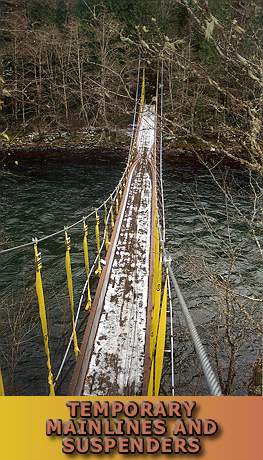Gorge Inn Suspension Bridge, 2000
Seattle City Light, Newhalem, WA

Satellite view of Bridge Location. (resolution not high enough to see bridge.) View Larger Map
|
Gorge Inn Suspension Bridge, 2000 Seattle City Light, Newhalem, WA
|
Satellite view of Bridge Location. (resolution not high enough to see bridge.) View Larger Map |
USE: Pedestrian
SPAN: 250'
TRAVEL WIDTH: 6'
TOWERS: 29' Tall D-Fir Framed Bents w/ 12" x 14" Legs
ANCHORS: Concrete Deadmen with 2-1/4 Steel Anchor Rods"
MAINLINES: 1-3/4" Bridge Strand

The Gorge Inn Suspension Bridge crosses the upper Skagit River at the small town of Newhalem, WA, in the heart of the North Cascades. Newhalem is a small company town that began as a remote propecting camp over a century ago and later became the administrative hub for development of a hydroelectric complex owned and operated by the City of Seattle. Under the direction of public power visionary James D. Ross, three dams were built in the rugged Skagit River drainage early in the 20th Century that remain anchors of the Seattle City Light electricity generation system today. At Newhalem, site of the Gorge Powerhouse, Seattle City Light continues to administer the town for the purpose of maintaining the hydroelectric complex. The last public services available to travellers before crossing Washington's North Cascade Highway eastbound are located at Newhalem, and the National Park Service built the North Cascade National Park Visitor Center here, across the Skagit River from town center. The Gorge Inn Suspension Bridge was built in 1969 by Seattle City Light and connects Newhalem Town Center to the National Park Visitor Center by trail.

The Gorge Inn Suspension
Bridge is a stiffened pedestrian suspension bridge utilizing a welded truss
of 4" x 6" tubular steel and bolted 3" x 3" angle iron.
The classic lines and combination of steel and timber components of this
attractive light-duty suspension bridge are reminiscent of cable bridges erected
in remote areas of the West since the early part of the 1900s. Unfortunately
the use of timber as a structural component in cable bridge design has limitations,
particularly as regards the anticipated useful life of the bridge. In October
2000, the badly compromised northern timber tower collapsed under the load of roughly 30
pedestrians. (As a point of reference, a suspension bridge in good working condition should support
a live load in excess of 60 lbs per square foot of deck with that amount tripled for a factor of safety; the designed live load of
a bridge such as the Gorge Bridge would have been 90,000 lbs, equivalent to 600 people.) On the day of the bridge failure, in spite of the bridge deck dropping more than 10 feet, there
were no injuries or fatalities; the remaining tower, together
with the stiffened truss, prevented total collapse of the bridge into the river.
The photos you see above show the bent and buckled truss after the collapse,
and the stabilization repair implemented by Sahale (below).
Stabilizing the bridge involved installation of temporary towers, mainlines and suspenders. The objective was to temporarily support the truss over the winter, while a plan for permanent repair could be developed and implemented. Sahale designed an interim system having tower and mainline geometry that would permit installation of permanent new towers (presumably of steel) and reinstallation of the original mainlines and suspenders while the temporary system remained in place. The temporary steel towers were approximately 25' tall, constructed of W8 x 30 beams and 4" x 4" x 3/8" angle. The temporary mainlines were 1-3/8" steel IWRC wire rope with spelter socket attachment via an 8" x 8" x 1" angle fitting to the original anchor rods. The temporary suspenders were 4" heavy ratchet straps. The factor of safety for the temporary system was slightly over 2, with snow load equivalent to 4' snow depth. Later in 2001, Sahale completed a permanent repair and structural upgrade including installation of new towers, replacement of damaged floor beams and truss members, and fitting of a redesigned sway brace system, returning the bridge to good working order.